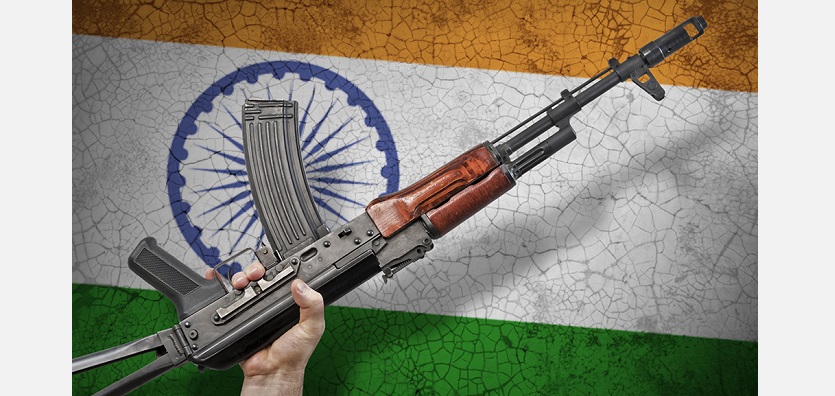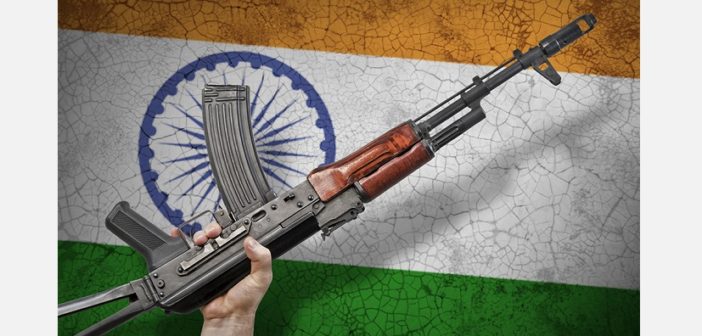

APSM Correspondent
For all its bluster of becoming a self-made world power with a $5 trillion economy in the next five years (from $2.7 trillion at present), India is backing into a situation where it is committing itself to exorbitant purchases of US arms to placate Washington.
Clearly, Prime Minister Narendra Modi’s “Make in India” mission is being smothered by US President Donald Trump’s overarching “America First” policy, where, despite the bilateral cordiality, the Trump administration is frequently undermining India’s interests in furthering its own.
Trump, after all, has been a high-flying businessman and has adroitly leveraged his entrepreneurial acumen to model the India-US relationship into largely a vendor-customer one. India, however, has not been reluctant to be the affable client, so long as it is reciprocally benefited from time to time.
“Make in India” was one of the numerous unrealised catchphrases of the Modi government that had sought to foster domestic manufacturing for import substitution, particularly in the field of defence. But in the over five years the government has been in power, shrinking manufacturing output has been pulling down industrial growth, with little evidence of any military industry taking shape.
India’s defence imports have thus only surged, as it craves the indulgence of an impulsive Trump administration to validate its aspirations for great power status. In its anxiety to keep the Trump administration in good humour, the Indian government has pivoted its defence spending to the US, which has now emerged as the second biggest supplier of military hardware to India, after Russia.
The US’s arms sales to India have risen more than fivefold over the last five years and now account for 15 per cent of India’s defence imports, according to the Stockholm International Peace Research Institute (SIPRI).
Defence procurements in the Indian context are largely a political decision rather than one premised on military and security considerations. This approach was magnified under the right-wing Bharatiya Janata Party (BJP)-led governments of 2014-19 and the present, where Prime Minister Modi, on his April 2015 state visit to France during his previous term, unilaterally signed a €7.87 billion deal with Dassault Aviation for 36 Rafale fighterplanes for the Indian Air Force (IAF). None in his Cabinet, including then Defence minister Manohar Parrikar, had any prior knowledge about the deal.
The deal implicitly annulled a past agreement between the previous Congress Party-led government and Dassault for 126 Rafales for a much cheaper price. That agreement had involved the outright import of 18 of the aircraft, with the balance 108 to be manufactured under licence in India by state-owned Hindustan Aeronautics Limited (HAL).
Rafale was selected over the other contenders, namely, Lockheed Martin’s F-16 Block 70, Boeing’s F/A-18 E/F Super Hornet, Saab’s JAS-39 Gripen, Eurofighter’s Typhoon and Mikoyan-Gurevich Corporation’s MiG-35. The Rafale was shortlisted alongside the Typhoon in May 2011 and ultimately awarded the tender in January 2012.
Lockheed and Boeing’s elimination had led the then US Ambassador to India, Timothy Roemer, to resign the very next day. He had been mindful of the fact that the then US President Barack Obama had written to the then Indian Prime Minister Manmohan Singh that favouring an American fighter would cement the Indo-US strategic partnership and be mutually beneficial in creating thousands of jobs in both the countries.
The choice of Rafale had also prompted the Pentagon to affirm, “We are deeply disappointed by this news, but we look forward to continuing to grow and develop our defence partnership with India.” Shortly thereafter, India cleared a $4.1 billion deal with Boeing for 10 C-17 Globemaster-III giant strategic airlift aircraft for the IAF, with options for six more for $1.7 billion. The Pentagon itself had halted their purchase as it had deemed the C-17 exorbitant ($200 million a unit then, without spares and training, and now $338 million). The deal with India, however, saved 23,000 American jobs, an aspect noted by Roemer himself.
Clouding Modi’s deal for 36 Rafales further had been the absence of any clarification on the 90 aircraft left out of his agreement and which were required by the IAF under the original tender. The IAF had made known this requirement back in 2005 when it had issued a Request for Information (RFI), or initial tender, for new jetfighters to replace the vintage Soviet-era MiGs that had been its mainstay since their induction in the early ‘80s. The Rafale tender had been the culmination of those protracted efforts.
This piecemeal deal besides undermines India’s security as it threatens to adversely affect India’s air defences. The IAF is already hamstrung by a depleting fleet, and is anticipated to diminish to just 26 squadrons of serviceable aircraft over the next two years against a sanctioned strength of 42. As there is considerable lag between the selection of military equipment and its delivery, much time has been lost through the partial deal.
It was only in April that the IAF issued a successor RFI for a total 114 jetfighters at a cost of $18 billion. The RFI has elicited responses from the same six contenders, with Lockheed offering its F-21 that it indicates has been “specifically configured for the IAF”, apart from its F-16 Block 70. The contract entails the import of 18 of the aircraft in fly-away condition, with the remaining 96 to be built in India by a joint venture with a private sector partner under the strategic partnership model.
The Oval office has for long been intent on an Indian decision favouring an American fighter as compensation for the contract going to Dassault. It is hence widely perceived that the part deal on the Rafale was designed to favour Washington in any follow-up contract on the jetfighters for the IAF.
It is no coincidence that both Lockheed and Boeing have positioned themselves expectantly in this regard. Lockheed signed an agreement with Tata Advanced Systems Limited (TASL), of the Mumbai-based Tata Group, in June 2017 for joint production of the F-16 Block 70 in India.
TASL has a similar agreement with Boeing, signed in November 2015, to co-develop integrated systems in aerospace and defence, starting with fuselages of the AH-64 Apache, acknowledged as the world’s most lethal combat helicopter. The first fuselage was delivered in June 2018.
The White House is thus believed to have extracted the concession from India to gift the contract to an American fighter for treating it differently from China and Turkey in the three countries’ purchase of Russia’s sophisticated S-400 Triumf air defence shield. The US has invoked its Countering America’s Adversaries Through Sanctions Act, or CAATSA, against Beijing and Istanbul. The Act prescribes sanctions against countries or individuals conducting defence deals with Russia that the US holds responsible for cyber interference in the US 2016 presidential election and for militarily intervening in eastern Ukraine.
Cherishing India’s worth as a sustained arms buyer, Washington has responded differently to New Delhi’s $5.4 billion purchase of five S-400s, deeming it unrealistic to prohibit Russian arms sales to India.
If India does opt for a US warplane on its $18 billion contract, Washington stands to gain even further as it looks to signing arms deals worth an additional $10 billion with New Delhi. It has already sold India some $18 billion worth of weaponry over the past decade.
While the Modi government had been enthused by the President’s initial pledges of an unshakeable friendship, some drastic measures have been unleashed against it by the Trump administration concerning trade, agriculture, immigration and even its relations with Russia and Iran that have forced India on the back foot.
Trump’s carrot-and-stick policy is paying rich dividends in this regard. The merchant-buyer bonds are playing out well. Oftentimes, much better for one than the other.






